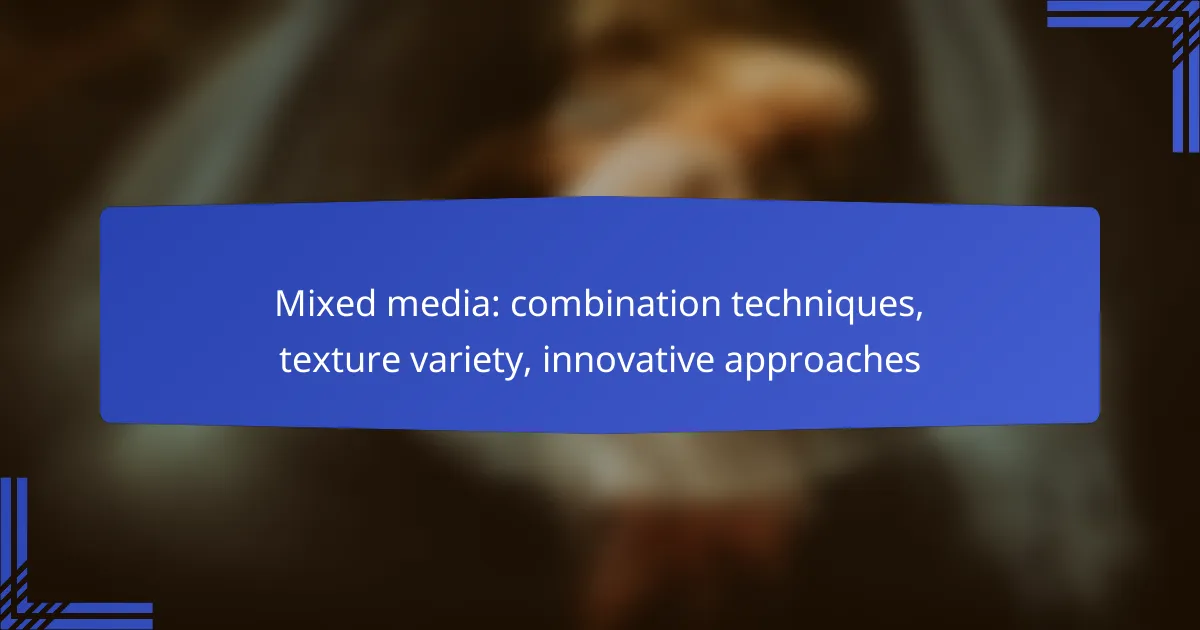Mixed media art harnesses the power of combining diverse techniques and materials to produce striking textures and visual narratives. By merging traditional and contemporary methods, artists can push the boundaries of creativity, resulting in innovative and engaging artworks. The incorporation of various textures not only adds depth but also invites viewers to interact with the piece on a sensory level, while emerging approaches like augmented reality and eco-friendly materials are redefining the art experience.
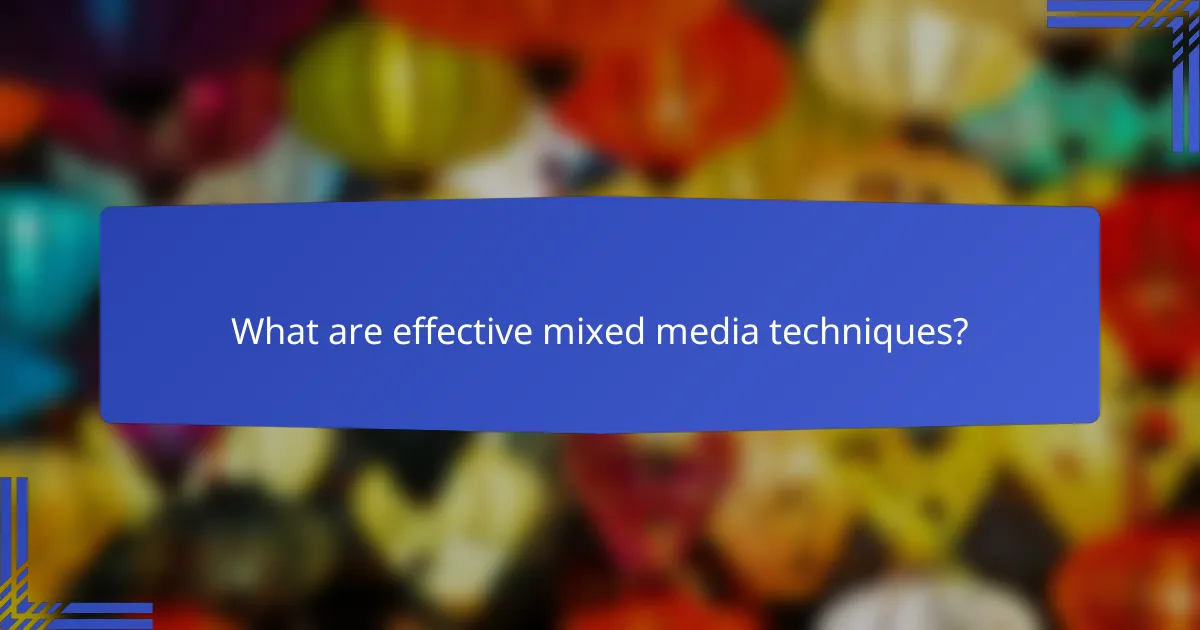
What are effective mixed media techniques?
Effective mixed media techniques involve combining various artistic methods and materials to create unique textures and visual effects. These approaches allow artists to explore creativity by blending traditional and contemporary elements, resulting in innovative artwork.
Collage combining paper and digital elements
Collage that merges paper and digital components is a popular mixed media technique. Artists can start by selecting printed images, textures, or patterns, then enhance these with digital tools like photo editing software. This combination allows for greater flexibility in design and the ability to easily adjust elements before finalizing the piece.
When creating a collage, consider the balance between physical and digital elements. Use high-quality scans of paper textures or images to maintain clarity and detail. Experiment with layering and transparency to achieve depth and visual interest.
Layering paint with photography
Layering paint with photography creates a striking contrast between the organic nature of paint and the precision of photographic images. Artists can print photographs on canvas or paper and then apply paint over or around these images to create a cohesive piece. This technique can evoke emotions and tell a story through the interplay of different mediums.
To effectively layer paint and photography, choose colors that complement the photograph. Use transparent or semi-transparent paints to allow the underlying image to show through. Be mindful of drying times, as some paints may react with the photo surface, affecting the final appearance.
Textured surfaces using fabric and paint
Creating textured surfaces with fabric and paint adds dimension and tactile quality to artwork. Artists can use various fabrics, such as burlap, lace, or denim, as a base or incorporate them into the design. Applying paint over these materials can enhance their texture and create visually engaging effects.
When working with fabric, ensure it is securely adhered to the surface to prevent peeling. Experiment with different paint types, such as acrylics or fabric paints, to achieve the desired finish. Consider layering fabrics for added complexity and depth.
Incorporating found objects in artwork
Incorporating found objects into mixed media artwork adds a unique, personal touch and can convey deeper meanings. Artists often use everyday items like buttons, twigs, or metal scraps to create visual interest and texture. This approach encourages creativity and resourcefulness, as the possibilities are virtually limitless.
When selecting found objects, consider their shape, color, and texture to ensure they harmonize with the overall composition. Secure objects with strong adhesives or fasteners to maintain stability. Be cautious of sharp edges or materials that may degrade over time, impacting the longevity of the artwork.
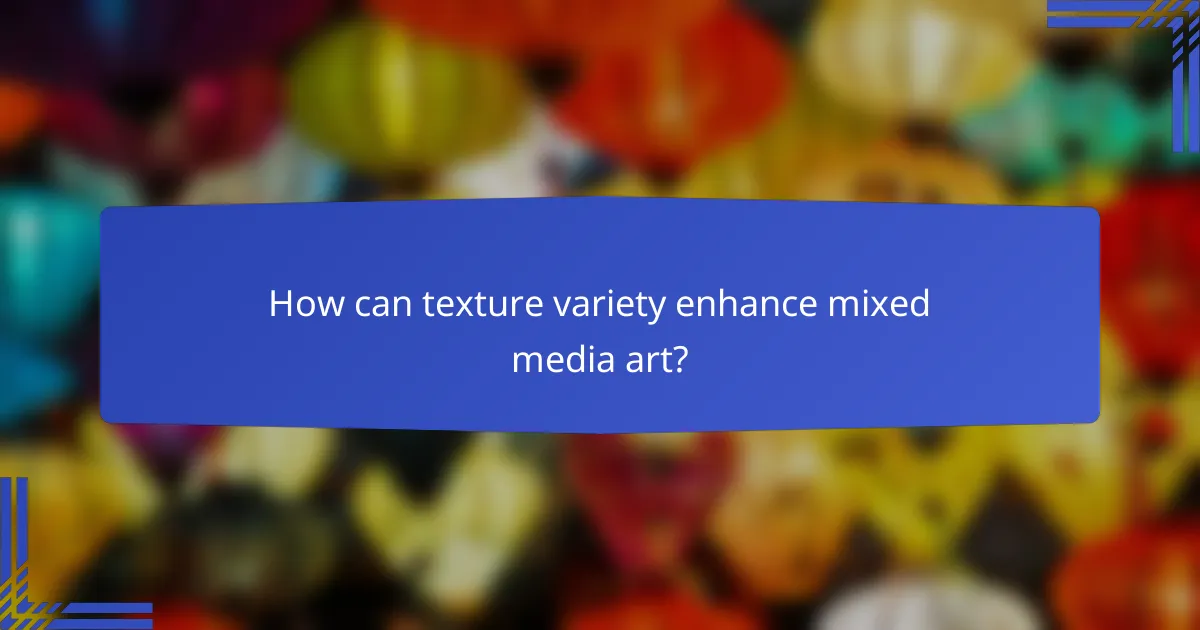
How can texture variety enhance mixed media art?
Texture variety can significantly enhance mixed media art by adding depth, interest, and sensory engagement. By incorporating different textures, artists can create dynamic compositions that invite viewers to explore the artwork more closely.
Creating depth with 3D elements
Incorporating 3D elements into mixed media art can create a sense of depth that flat surfaces cannot achieve. Techniques such as layering materials, using found objects, or adding sculptural components can draw the viewer’s eye and create visual intrigue. For example, adding small wooden blocks or fabric scraps can elevate certain areas of the artwork, making them stand out.
When working with 3D elements, consider the balance between the flat and raised areas to maintain harmony in your composition. Experimenting with different heights and placements can lead to unexpected and engaging results.
Using different materials for tactile experiences
Utilizing a variety of materials can enhance the tactile experience of mixed media art, inviting viewers to interact with the piece on a sensory level. Materials like sand, fabric, or metal can evoke different feelings and reactions, making the artwork more memorable. For instance, a canvas that combines smooth paint with rough sand can create a striking contrast that encourages touch.
When selecting materials, think about how they complement each other and the overall theme of your artwork. Mixing organic materials with synthetic ones can also create interesting juxtapositions that enhance the narrative of the piece.
Contrasting smooth and rough textures
Contrasting smooth and rough textures in mixed media art can create visual tension and highlight specific areas of the artwork. Smooth surfaces, such as glossy paint or polished paper, can draw attention, while rough textures, like burlap or textured paste, can provide a grounding element. This contrast can guide the viewer’s gaze and emphasize focal points within the composition.
To effectively use this technique, consider the placement of smooth and rough textures in relation to each other. A common approach is to use rough textures in the background and smooth ones in the foreground, creating a layered effect that enhances depth and interest.

What innovative approaches are trending in mixed media?
Innovative approaches in mixed media are reshaping how artists create and engage with their audiences. Techniques such as augmented reality, eco-friendly materials, and interactive experiences are gaining traction, allowing for more immersive and sustainable art forms.
Augmented reality in art installations
Augmented reality (AR) enhances traditional art by overlaying digital elements onto physical works. Artists can use AR to create interactive experiences that allow viewers to engage with the artwork through their smartphones or tablets, bringing static pieces to life.
For example, an artist might create a mural that, when viewed through an AR app, reveals animated elements or additional layers of information. This approach not only captivates audiences but also encourages them to explore the narrative behind the artwork.
Eco-friendly materials for sustainability
Using eco-friendly materials in mixed media art is becoming essential for artists committed to sustainability. Options such as recycled paper, organic paints, and biodegradable adhesives help reduce environmental impact while maintaining artistic integrity.
Artists can source these materials from local suppliers to support community economies and minimize transportation emissions. Additionally, integrating natural elements like plant-based dyes can enhance the aesthetic appeal while promoting eco-conscious practices.
Interactive mixed media experiences
Interactive mixed media experiences invite audiences to participate in the creation or alteration of the artwork. This can include installations that respond to viewer movements or sound, making the audience an integral part of the artistic process.
For instance, a gallery might feature a digital canvas that changes based on audience interaction, allowing for a unique experience with each visit. This approach fosters a deeper connection between the viewer and the artwork, transforming passive observation into active engagement.
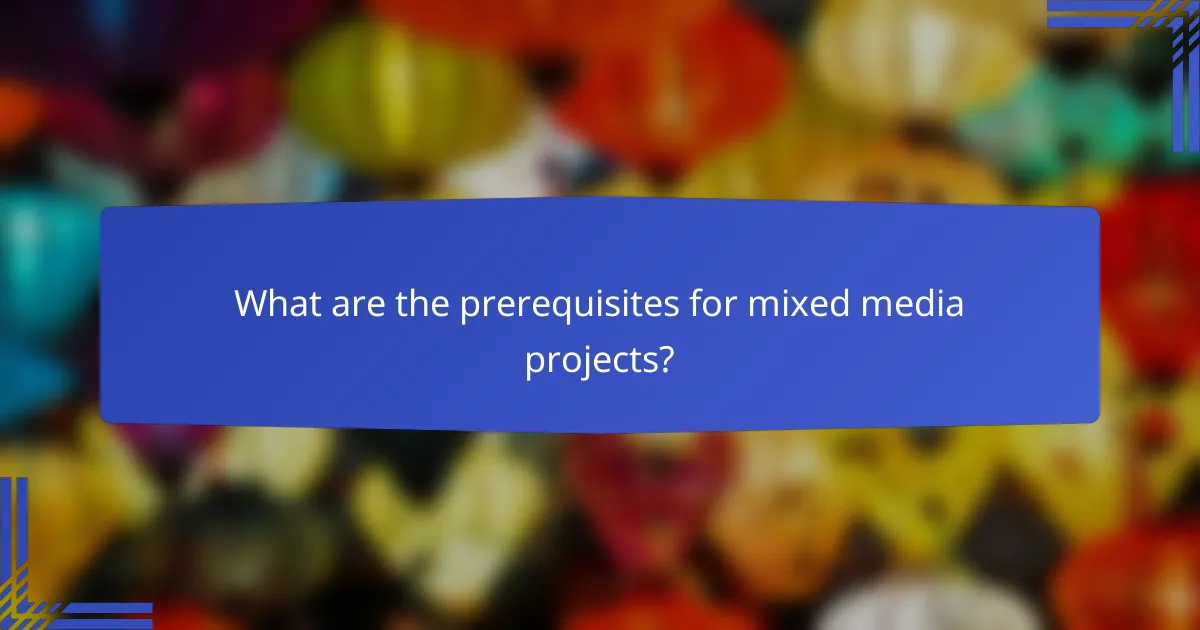
What are the prerequisites for mixed media projects?
To successfully engage in mixed media projects, artists should have a foundational understanding of various art materials and techniques. This knowledge allows for the effective combination of different mediums, enhancing creativity and expression.
Basic knowledge of art materials
Familiarity with a range of art materials is essential for mixed media projects. This includes understanding the properties and best uses of items like acrylics, watercolors, pastels, and collage materials. Each medium interacts differently, so knowing how they blend or contrast can significantly impact the final artwork.
Additionally, artists should be aware of the tools required for each medium, such as brushes, palette knives, or adhesives. Experimenting with various materials can help identify personal preferences and strengths, leading to more innovative combinations.
Understanding color theory and composition
A solid grasp of color theory is crucial for creating visually appealing mixed media pieces. Artists should understand how colors interact, including concepts like complementary colors and color harmony. This knowledge helps in selecting palettes that evoke desired emotions and ensure balance in the artwork.
Composition is equally important, as it dictates how elements are arranged within the artwork. Familiarity with principles such as the rule of thirds or leading lines can guide artists in creating dynamic and engaging pieces. Regular practice and analysis of existing works can enhance these skills over time.
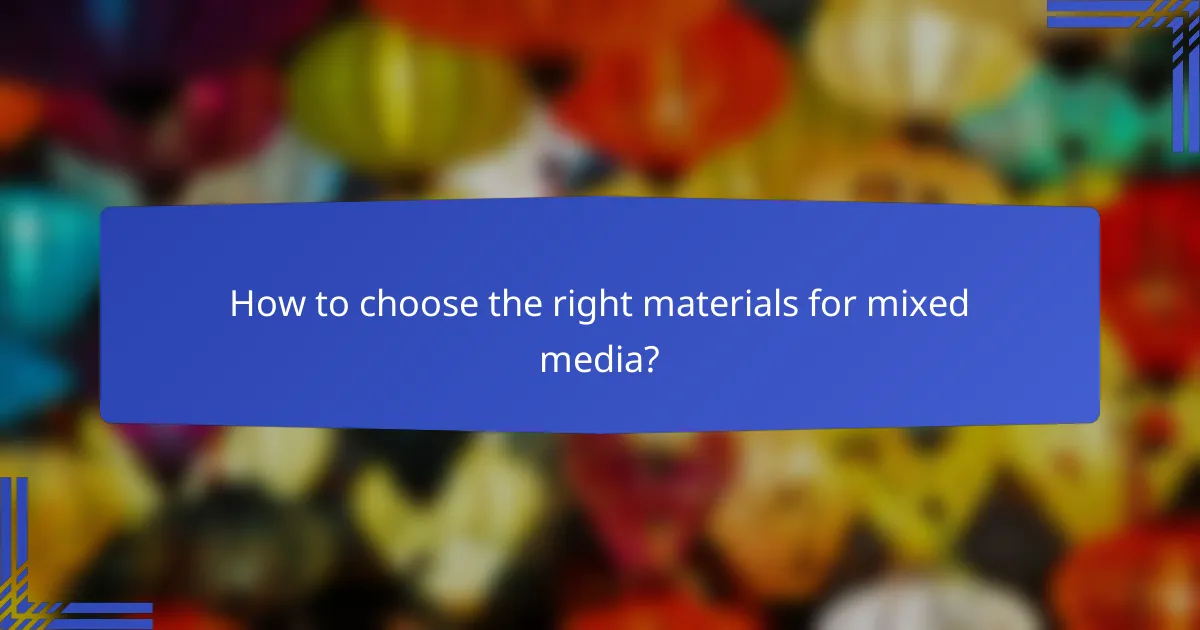
How to choose the right materials for mixed media?
Choosing the right materials for mixed media involves understanding their properties and how they interact with each other. Consider factors like texture, adhesion, and the intended visual effect to create a cohesive artwork.
Evaluating durability and compatibility
Durability is crucial when selecting materials for mixed media projects. Ensure that the materials can withstand environmental factors such as humidity and temperature changes, especially if the artwork will be displayed in varying conditions.
Compatibility between materials is equally important. For instance, oil-based paints may not adhere well to water-based mediums. Testing small samples before committing to a full project can help identify potential issues.
Considering the final display environment
The final display environment significantly influences material choice. If the artwork will be placed outdoors, opt for weather-resistant materials that can endure exposure to sunlight and moisture.
For indoor displays, consider the lighting and wall color. Bright colors may fade under direct sunlight, while certain textures may look different under artificial light. Always visualize how the mixed media piece will interact with its surroundings before finalizing your materials.
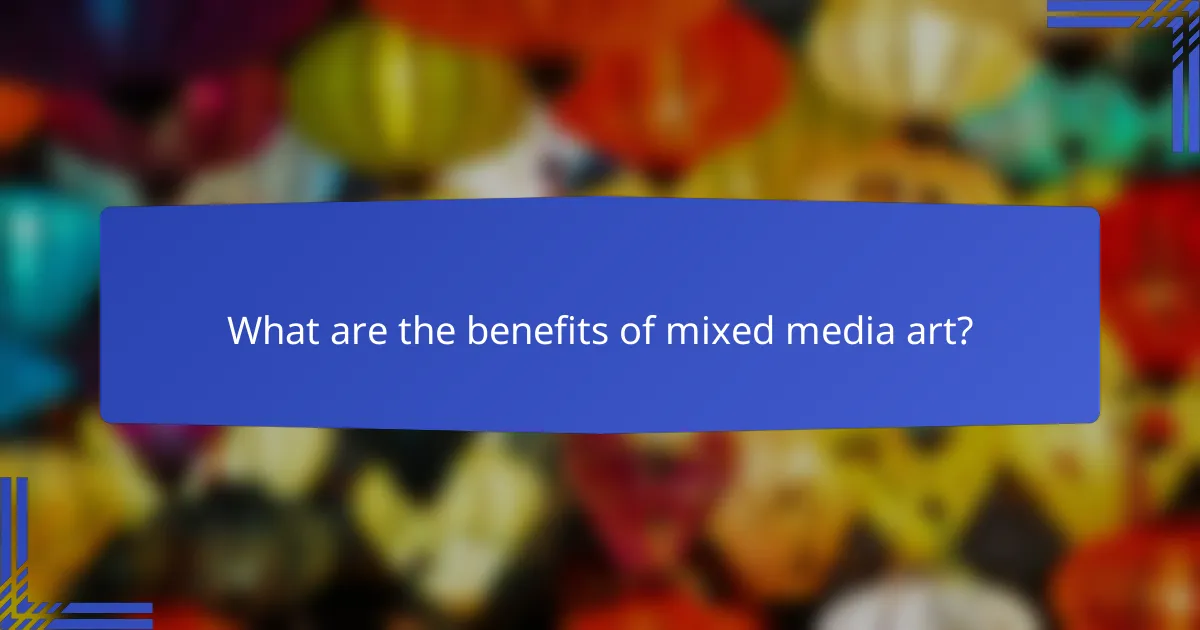
What are the benefits of mixed media art?
Mixed media art offers numerous benefits, including enhanced creativity and the ability to convey complex narratives. By combining various materials and techniques, artists can explore new dimensions and express their ideas more vividly.
Encourages creativity and experimentation
Mixed media art encourages artists to break free from traditional boundaries, allowing for greater creativity and experimentation. By using diverse materials such as paint, paper, fabric, and found objects, artists can discover unique combinations and techniques that enhance their work.
Experimentation can lead to unexpected results, which often inspire new ideas and directions in an artist’s practice. For instance, layering different textures can create depth and intrigue, prompting artists to explore further variations in their style.
Allows for personal expression and storytelling
Mixed media art provides a powerful platform for personal expression and storytelling. Artists can incorporate elements that reflect their experiences, emotions, and cultural backgrounds, making their work more relatable and impactful.
By integrating various materials, artists can create visual narratives that resonate with viewers on multiple levels. For example, using photographs alongside paint can evoke memories or convey a specific message, enriching the overall storytelling aspect of the artwork.
